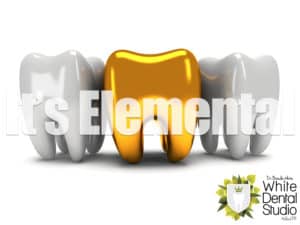 Why aren’t dental crowns made of silver?
Why aren’t dental crowns made of silver?
I was recently asked by my brother-in-law, with a strong background in metals and engineering, why dental crowns are made of gold rather than silver since silver has a natural antibacterial quality (shout out to you, Lake!). Surprisingly, those gold crowns actually have a considerable amount of silver present in the alloy! The biggest reason I prefer high-gold containing crowns is their biologic compatibility – the material lasts under the functional and environmental loads of the mouth AND the vital tissue around it does not react to the presence of the metal. Alloys for crowning teeth come in so many different compositions and varieties, it is hard to keep them straight. We categorize gold crowns based on their quantity of precious metals – typically gold and palladium – while also looking at the remaining metals for quality and compatibility. One of my preferred gold alloys consists of 62% gold, 3% palladium, and 25% silver, which provides a beautiful gold restoration every time. On top of that, gold can be polished amazingly well and these alloys are not the same as silver fillings in that there isn’t the same corrosive process occurring when placed. So, with a highly polished Gold crown, we have happy gum tissue, a surface that is resistant to plaque formation and accumulation (via a high shine polish), and a fit and finish that is nearly unmatched in accuracy and durability.
Dental Crowns in Ashland, OR
But there’s a catch! It’s still gold, which isn’t white, and teeth are supposed to be white. Fortunately the materials science is catching up to the esthetic demands of today. We will touch on the exciting world of biocompatible, esthetic dental ceramics in another posting. I bet you can’t wait!
Love science? Check out our recent post, “Dental Chemistry | Just the Basics!”
Post written by: Brandon White, DDS, owner/dentist at White Dental Studio in Ashland, OR

Recent Comments